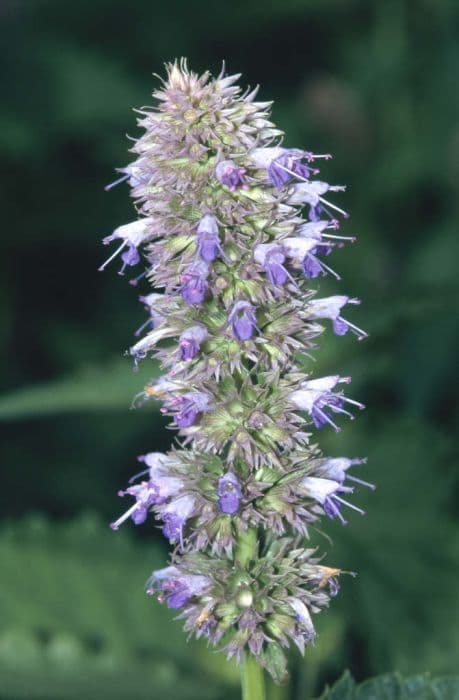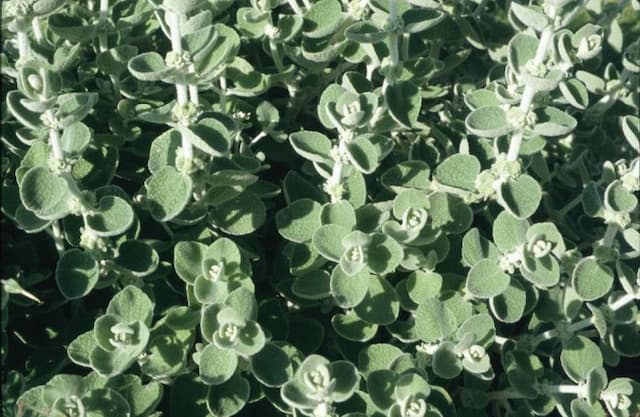Coleus Solenostemon scutellarioides 'Wisley Tapestry' (v)

ABOUT
The plant commonly known as 'Wisley Tapestry' Coleus showcases a vibrant array of foliage colors and patterns. The leaves are the most striking feature, presenting a rich tapestry of hues, including deep burgundy, green, and cream. Each leaf exhibits a unique pattern with variegation that can look marbled or splashed across the surface. The edges of the leaves are often scalloped or serrated, adding a textured look to the foliage. The colors are most intense when the plant is grown in bright light but not direct sunlight. The plant can produce small flowers, but they are typically less showy than the striking leaves and are often removed to keep the focus on the foliage. Overall, 'Wisley Tapestry' Coleus is cherished for its ornamental leaves, which can add a splash of color to any garden or indoor space.
About this plant
 Names
NamesFamily
Lamiaceae.
Synonyms
Coleus, Painted Nettle.
Common names
Coleus blumei, Coleus blumei var. verschaffeltii, Coleus hybridus, Coleus scutellarioides, Coleus verschaffeltii, Solenostemon scutellarioides.
 Toxicity
ToxicityTo humans
Coleus is generally considered non-toxic to humans. However, it's always advisable to avoid ingesting plants that are not meant for consumption, as they may cause gastrointestinal discomfort or other non-specific symptoms in some individuals. There have been no widely reported toxic effects from ingesting coleus.
To pets
Coleus, while not severely toxic, may cause mild gastrointestinal upset if ingested by pets such as cats or dogs. Symptoms from consuming parts of the plant might include vomiting, diarrhea, and a depressed appetite. It is advisable to keep an eye on your pet and consult with a veterinarian if you notice these symptoms.
 Characteristics
CharacteristicsLife cycle
Perennials
Foliage type
Deciduous
Color of leaves
Variegated
Height
2 feet (60 cm)
Spread
2 feet (60 cm)
Plant type
Herb
Hardiness zones
9
Native area
Southeast Asia
Benefits
 General Benefits
General Benefits- Visual Appeal: The Solenostemon scutellarioides 'Wisley Tapestry', commonly known as Coleus, features vibrant foliage that adds color and texture to garden spaces or indoor settings.
- Versatility: Coleus can be grown in both indoor and outdoor environments, making it a highly adaptable choice for gardeners and interior decorators.
- Easy Propagation: Coleus plants can be easily propagated from cuttings, making them cost-effective and simple to spread throughout your garden or share with friends.
- Low Maintenance: These plants require minimal care, thriving in a variety of light conditions and requiring only moderate watering and occasional fertilization.
- Tolerance to Shade: Coleus grows well in shaded areas where other plants might struggle, providing a burst of color in less sunny spaces.
- Companion Planting: Its diverse range of colors and patterns makes it an excellent companion plant, helping to accentuate and complement the flowers and foliage of neighboring plants.
- Temporary Ground Cover: Coleus can be used as a fast-growing temporary ground cover to fill in gaps in the landscape while permanent plants mature.
- Seasonal Flexibility: Being tender perennials, they can be overwintered indoors in colder climates, preserving their beauty for the following season.
- Container Gardening: Coleus is well-suited to pot culture, which makes it perfect for balconies, patios, and other areas where in-ground gardening isn't possible.
- Habitat Diversity: These plants can contribute to the ecological variety of a garden, supporting the overall health and aesthetic diversity of the space.
 Medical Properties
Medical PropertiesThis plant is not used for medical purposes.
 Air-purifying Qualities
Air-purifying QualitiesThis plant is not specifically known for air purifying qualities.
 Other Uses
Other Uses- Coleus 'Wisley Tapestry' can be used in terrariums, providing vibrant foliage and contrasting textures to the miniature landscapes within.
- This plant can act as a natural indicator of light conditions, as the intensity of its foliage color can change depending on light exposure, alerting gardeners to too much or too little light.
- Due to its colorful leaves, Coleus 'Wisley Tapestry' can be used in educational settings to teach children about plant pigmentation and photosynthesis.
- It is often used in container arrangements, not just for ornamental purposes, but to provide shade for the roots of sun-sensitive companion plants.
- Coleus 'Wisley Tapestry' can be grown as a living mulch, which helps to maintain soil moisture and reduce weed growth around larger plants.
- Pressed or dried coleus leaves from this cultivar can be used in crafts such as scrapbooking or decoupage for their intricate and colorful patterns.
- The plant may be grown as a form of temporary ground cover for events or garden tours, providing a splash of color for the occasion.
- As a fast-growing plant, Coleus 'Wisley Tapestry' can be used in garden design to quickly fill gaps where other plants have failed or to create instant visual impact.
- The distinctive foliage of Coleus 'Wisley Tapestry' can be used as a colorful backdrop in photography to make other subjects stand out.
- When interplanted with vegetables, the coleus can help attract beneficial insects and deter some pests due to its vibrant colors and complex leaf shapes.
Interesting Facts
 Feng Shui
Feng ShuiThe Coleus 'Wisley Tapestry' is not used in Feng Shui practice.
 Zodiac Sign Compitability
Zodiac Sign CompitabilityThe Coleus 'Wisley Tapestry' is not used in astrology practice.
 Plant Symbolism
Plant Symbolism- Variety and Diversity: The 'Wisley Tapestry' cultivar of Coleus features a mix of vibrant colors and patterns, symbolizing the beauty of diversity and the richness that comes from combining different elements.
- Intuition and Inner Vision: Coleus is sometimes associated with heightened awareness and spiritual insight, representing an individual's ability to see beyond the obvious and trust their inner vision.
- Transformation and Change: With its ability to change color intensity depending on light conditions, Coleus often symbolizes transformation, adaptability, and the willingness to change.
- Expressiveness and Creativity: The striking appearance of Coleus 'Wisley Tapestry' encourages self-expression and symbolizes the flourish of creativity, much like a tapestry that represents intricate craftsmanship and artistic diversity.
- Boldness and Confidence: The bold patterns and colors of the Coleus leaves represent confidence and the courage to stand out, much like an individual who is unafraid to be seen or to take the lead.
 Water
WaterColeus 'Wisley Tapestry' prefers consistently moist soil, which typically means watering thoroughly once the top inch of the soil feels dry to the touch. Depending on environmental conditions, this may equate to watering once every few days to once a week, with a likelihood of needing about one gallon of water per week during active growth periods. It's best to water the plant at the base to avoid wetting the foliage, which can lead to leaf disease. In winter, reduce watering as the plant's growth slows down, but do not allow the soil to completely dry out. Always ensure proper drainage to prevent waterlogging, as coleus is sensitive to overwatering.
 Light
LightColeus 'Wisley Tapestry' thrives in bright, indirect light or partial shade. Avoid direct sunlight, as this can cause the leaves to fade and diminish the vibrant colors. A north- or east-facing window is an excellent spot to provide the right amount of light without being too intense. If grown outdoors, it should be placed in a location that receives filtered sunlight or light shade, especially during the hottest parts of the day.
 Temperature
TemperatureColeus 'Wisley Tapestry' prefers temperatures between 60 to 75 degrees Fahrenheit. It can tolerate a minimum temperature of about 50 degrees Fahrenheit, but anything lower may harm the plant. During hot summers, ensure the coleus has some protection from extreme heat. This foliage plant is not frost-hardy, so it should be brought indoors or protected when the temperature is expected to drop below 50 degrees Fahrenheit.
 Pruning
PruningPruning Coleus 'Wisley Tapestry' encourages bushier growth and prevents the plant from becoming leggy. Pinch back the tips of the stems regularly, especially during the spring and summer months. Pruning can be done as needed throughout the growing season. The best time to do heavy pruning is in the early spring, just as new growth begins, to shape the plant and stimulate lush foliage.
 Cleaning
CleaningAs needed
 Soil
SoilColeus 'Wisley Tapestry' thrives in well-draining, nutrient-rich soil with a slightly acidic to neutral pH of 6.0 to 7.0. A mix of two parts peat moss or coco coir, one part perlite, and one part compost or worm castings makes an ideal soil blend for this vibrant plant.
 Repotting
RepottingColeus 'Wisley Tapestry' should be repotted annually or when it becomes root-bound. Typically, young plants grow rapidly and might need repotting twice a year, while mature plants are generally repotted once a year to refresh the soil and provide more room for growth.
 Humidity & Misting
Humidity & MistingColeus 'Wisley Tapestry' prefers high humidity levels, ideally between 60-70%. Maintaining a humid environment can be achieved by grouping plants together, using a pebble tray, or employing a humidifier.
 Suitable locations
Suitable locationsIndoor
Keep Coleus in bright, indirect light and away from drafts.
Outdoor
Plant in partial shade, protect from strong winds, water regularly.
Hardiness zone
10-11 USDA
 Life cycle
Life cycleSolenostemon scutellarioides 'Wisley Tapestry', commonly known as Coleus, begins its life cycle with seed germination, where it requires warm temperatures and consistent moisture to emerge. Once sprouted, the seedlings grow rapidly, developing distinctive colorful foliage that is variegated and requires bright, indirect light to maintain its vibrant colors. The juvenile plants are then transplanted into individual pots or garden beds where they continue to grow, with pinching back the tips encouraging bushier growth. During its active growth phase, Coleus flourishes in warm weather and can be propagated through stem cuttings, which root easily in water or soil. This perennial, often grown as an annual in cooler climates, reaches full maturity within a single growing season, producing small, less noticeable flowers that are often removed to keep the plant's energy focused on foliage production. As temperatures drop, Coleus plants grown outside must be protected from frost or brought indoors, while in tropical climates, they can survive year-round if cared for properly.
 Propogation
PropogationPropogation time
Spring-Early Summer
The most popular method of propagating Solenostemon scutellarioides 'Wisley Tapestry', commonly known as Coleus, is through stem cuttings. This method is usually best performed in the spring or early summer when the plant is actively growing. To propagate Coleus, a healthy stem cutting about 4 to 6 inches long is taken from the parent plant. The lower leaves are removed, and the cut end can be dipped in rooting hormone to encourage root growth. The cutting is then planted in a pot with moist, well-draining soil or placed in water to root. If rooted in soil, the medium should be kept consistently moist but not soggy until roots have developed, which typically takes about two weeks. Transplanting can be done once the new roots are an inch (approximately 2.5 centimeters) or longer.









